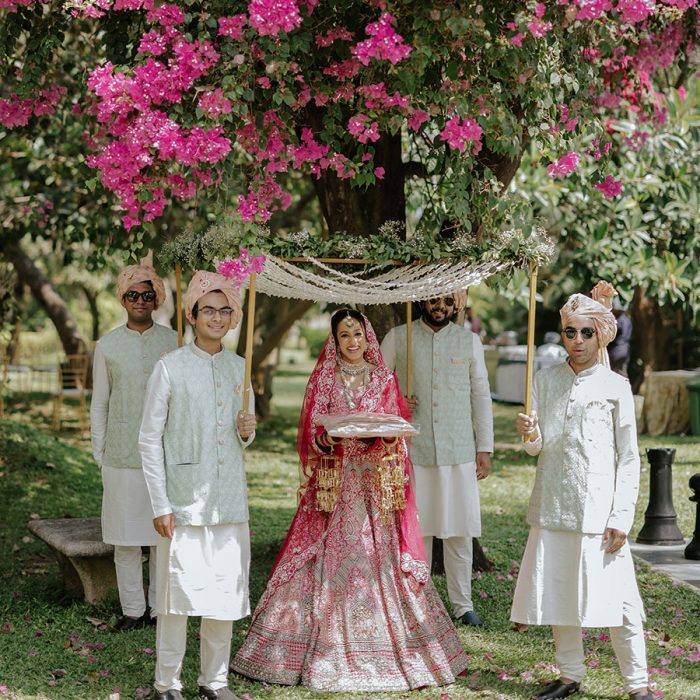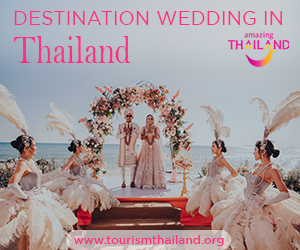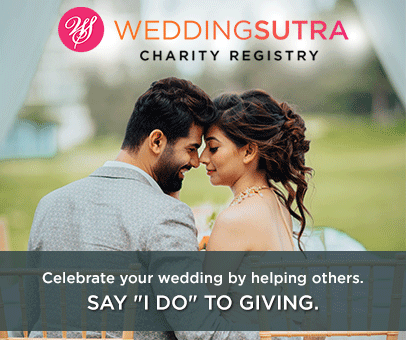Punjabi Weddings: Customs and Traditions
Rituals, customs, style and more! Here's everything you need to know about Punjabi weddings.
Food, fun and a whole lot of dancing!! Undeniable parts of Punjab’s vibrant culture, these things are definitely what come to mind when we think of a Punjabi wedding. Add to that, some shimmering, colorful outfits, extravagant décor and an open bar for the ultimate big fat wedding! However, loud revelries aren’t all there is to it. As we closely explore the authentic pomp and splendor of Punjabi wedding traditions, we bring you this installment of the Wedding Tradition Series: a kaleidoscopic guide to different regional cultures spanning rituals, customs, fashion and more.
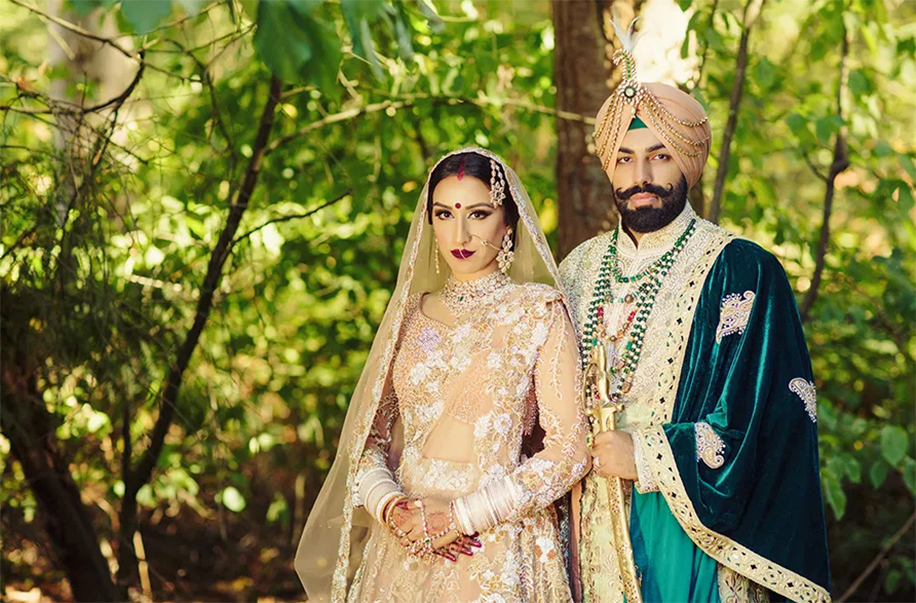
As more couples from different cultures or even countries tie the knot, they desire a beautiful blend of celebrations that will stay with them and their guests forever. Whether you are a bride or groom-to-be at the helm of your wedding planning, or a guest invited to a friend’s big day, coordination for a celebration that is new to you can often get stressful. This wedding tradition series is aimed to answer all your queries about ceremonies and the meaning behind them, how to dress for different functions and unique aspects of the experience to embrace, traversing one culture at a time.
Welcome to the wonderful, vibrant world of Punjabi weddings!
Wedding Functions
Roka/Thaka:
The first in a long line of rituals, Roka (derived from the word ‘rokna’ or ‘stop’) implying the end of the search for a suitable partner, marks the decision of two families to consolidate a relationship. It is celebrated with the bride’s family, traditionally without the bride, visiting the groom’s home to bless their union with gifts like fruits, sweets, clothes, money and other valuables.
The groom’s family then reciprocates the gesture by visiting the bride’s home with gifts or ‘shagun’, which is showered on the couple. This ritual is called Thaka.
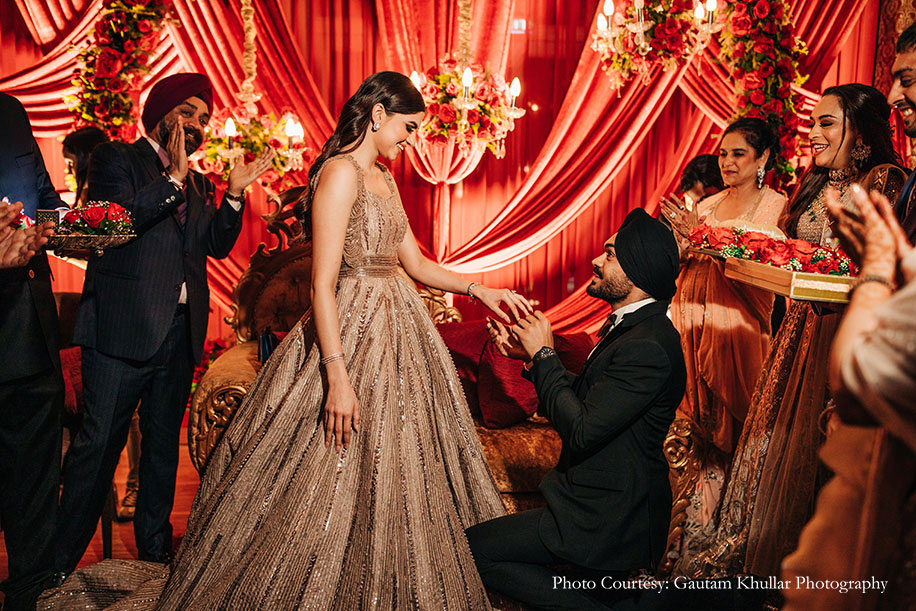 Photo Courtesy: Gautam Khullar Photography
Photo Courtesy: Gautam Khullar Photography
Chunni Ceremony:
The Chunni ceremony is a symbolic gesture by the groom’s mother and other female relatives to the bride, welcoming her into the family. Armed with sweets, gifts, jewelry, the engagement attire and more, they visit the bride’s parents’ home with a red ‘chunni’ or drape for her head as a veil and token to bless her for the future while welcoming her as their daughter-in-law.
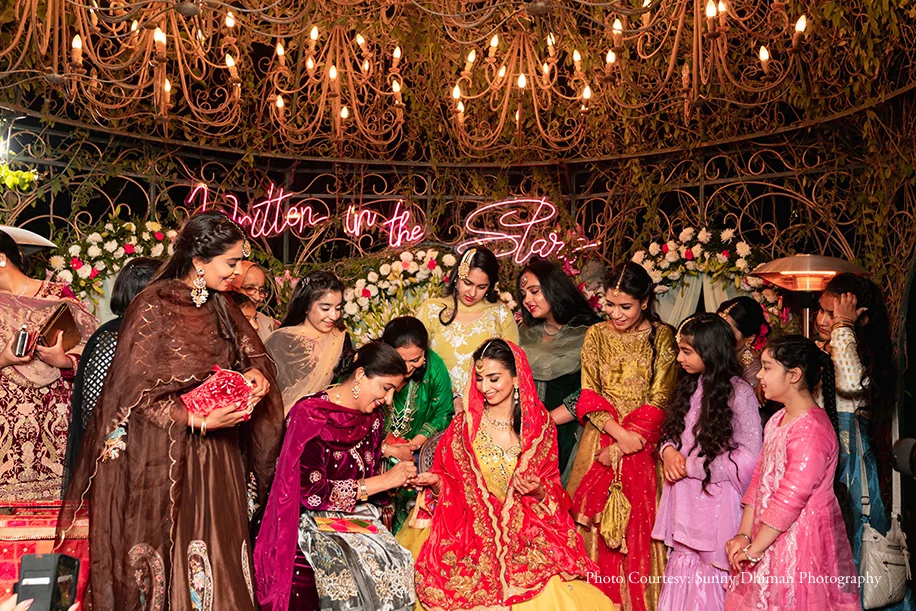 Photo Courtesy: Sunny Dhiman Photography
Photo Courtesy: Sunny Dhiman Photography
Sagai (Engagement):
Often held on the same day as the Chunni ceremony, and sometimes even simultaneously, the Sagai ceremony or the engagement ceremony constitutes the ring exchange between the bride and the groom. The family members then bless the match with a small puja. In general, functions up till this are very intimate and just include the family. The engagement however can be as big or small as one wants.
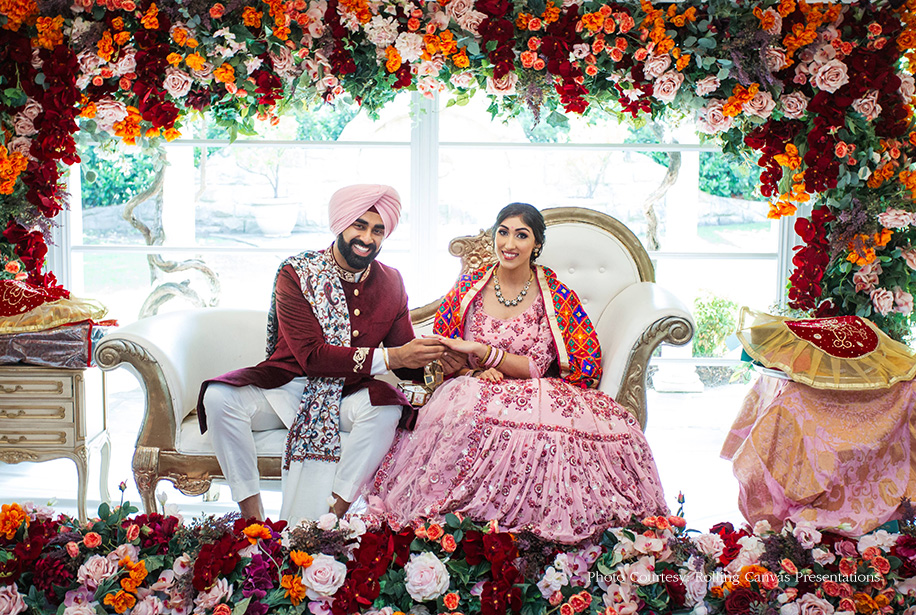 Photo Courtesy: Rolling Canvas Presentations
Photo Courtesy: Rolling Canvas Presentations
Ladies’ Sangeet:
The most awaited function in a wedding, the Sangeet is a night of music, dance and non-stop revelry! Traditionally arranged by the bride’s family, it was the Indian equivalent of a hen party where the ladies of the family got together and sang folk songs, danced and teased the bride. Today, it is a full-blown musical night involving both families and includes everything from choreographed performances to event hosts, and sometimes even hired artists.
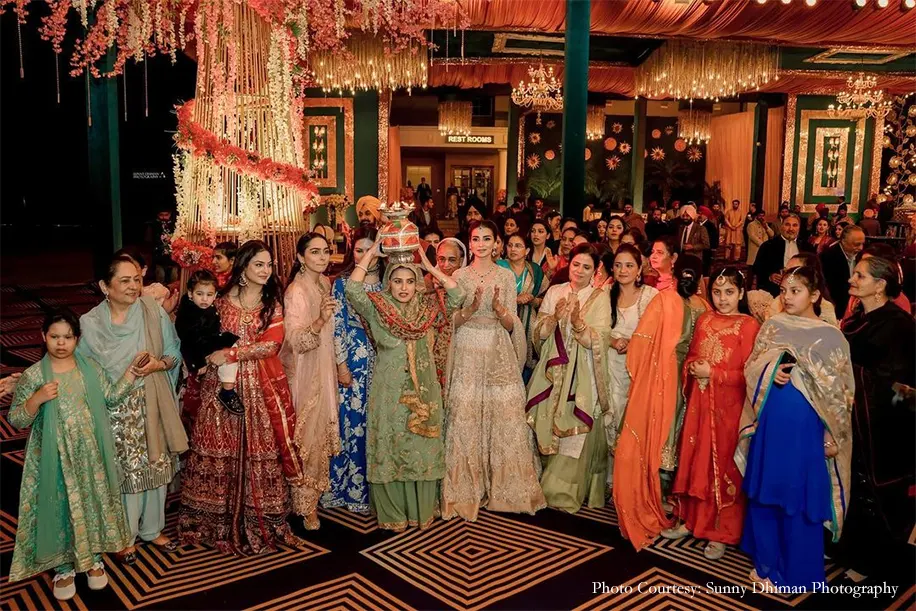
Mehndi:
A vital part of all Indian weddings, the Mehndi, generally held during the day or afternoon, is a ceremony of the bride getting her hands, arms and feet painted with henna. The designs often take inspiration from the couple’s names, their favorite things or their love story. The bride’s close friends and family also get their hands painted with henna, albeit with smaller, less intricate designs. Like the Sangeet, this ceremony was traditionally held within the bride’s family. Today, celebrated at a much larger scale, it includes both families and other guests amidst eclectic and vibrant décor, dotted with fun food stalls and filled with entertainment!
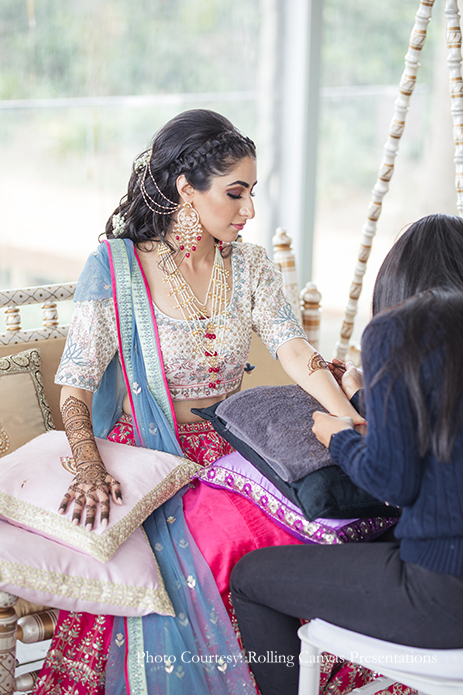
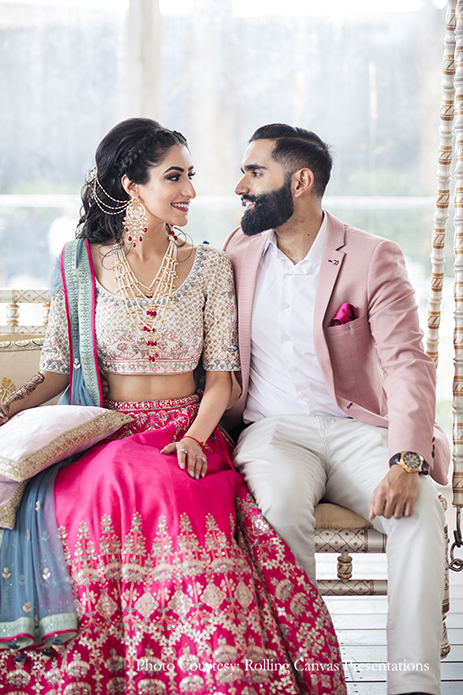
Photo Courtesy: Rolling Canvas Presentations
Jaggo:
Held the night before the wedding, this family event is a loud celebration in front of the beautifully decorated house with music, firecrackers, dancing and sweets, late into the hours of the night. Copper vessels are decorated with lamps that are lit, and carried by the maternal aunt while another lady carrying a stick with bells shakes it. Singing folk songs, the family visits the houses of their friends and relatives, who feed them sweets and join in the revelries.
This tradition is often skipped out as per choice or convenience, especially in destination weddings.
 Photo Courtesy: Happyframes
Photo Courtesy: Happyframes
Kangna Bandhana:
The first ceremony of the wedding day, this event consists of a pooja, after which the priest ties a scared thread called ‘mouli’ with a betel nut and a shell around the couple’s right wrists. Meant as a symbol of good luck, it is not to be taken off, and only needs to unravel by itself eventually.
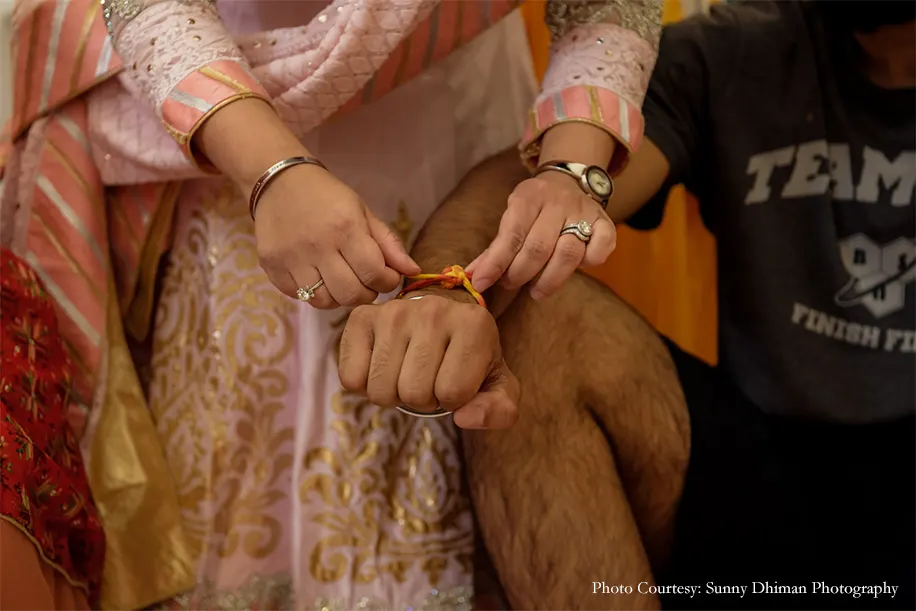
Chura and Kaleerein:
Symbolic of a newly married woman, the chura is a set of ivory and red bangles that are worn by the bride for 40-45 days after her marriage. During the ceremony, the maternal uncle of the bride sits for a havan during which the chura (bangles) are purified in milk and rose petals, and slipped on to the bride’s wrists, after which she is gifted her wedding attire.
Following the ceremony, the bride’s sisters and friends tie the kaleerein to her wrists. These are umbrella shaped ornaments that are traditionally encrusted with betel nuts, dry fruits and coconuts. In a ceremony similar to a bouquet toss in catholic weddings, the bride rattles her kaleerein over the head of single women at the wedding, and whoever it falls on is said to be in line to get married next.
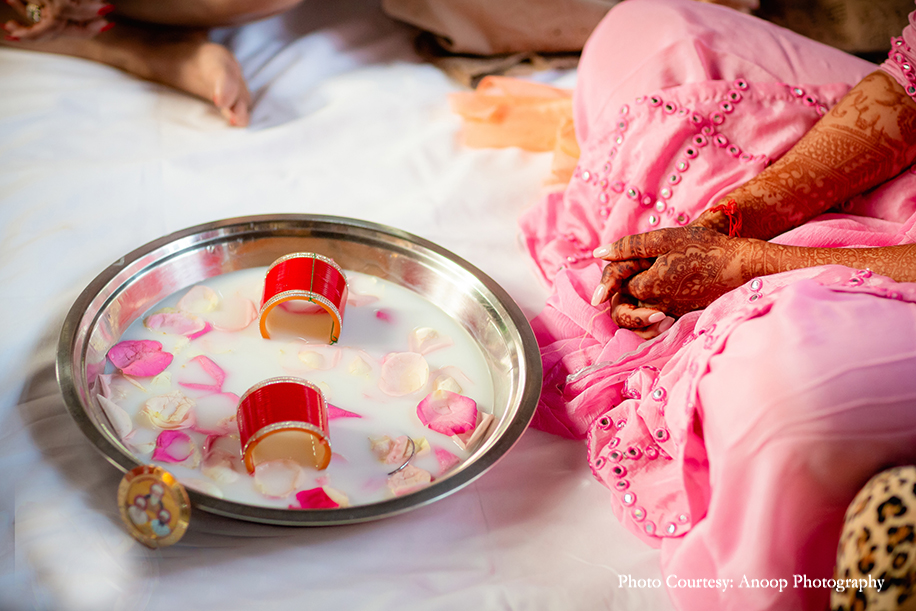 Photo Courtesy: Anoop.Photography
Photo Courtesy: Anoop.Photography
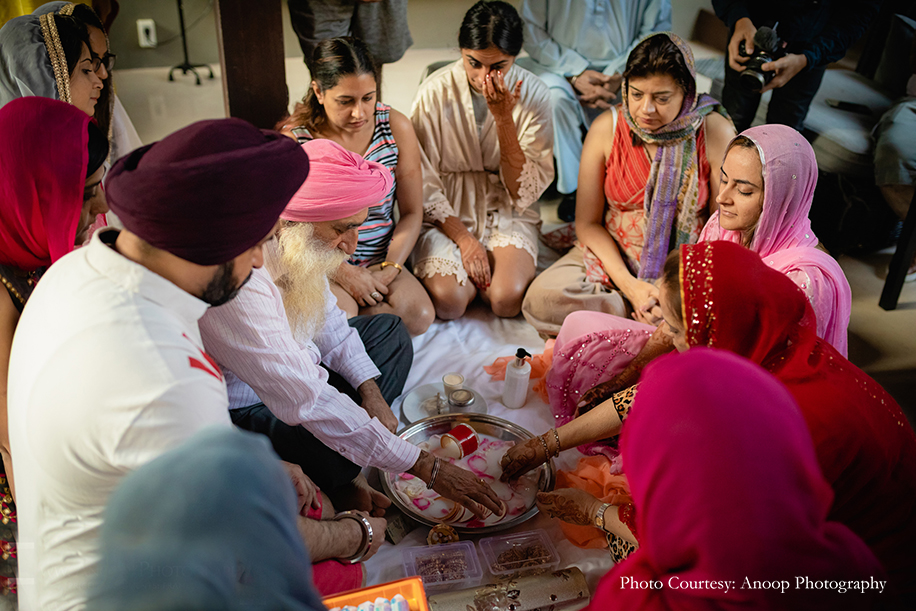 Photo Courtesy: Anoop.Photography
Photo Courtesy: Anoop.Photography
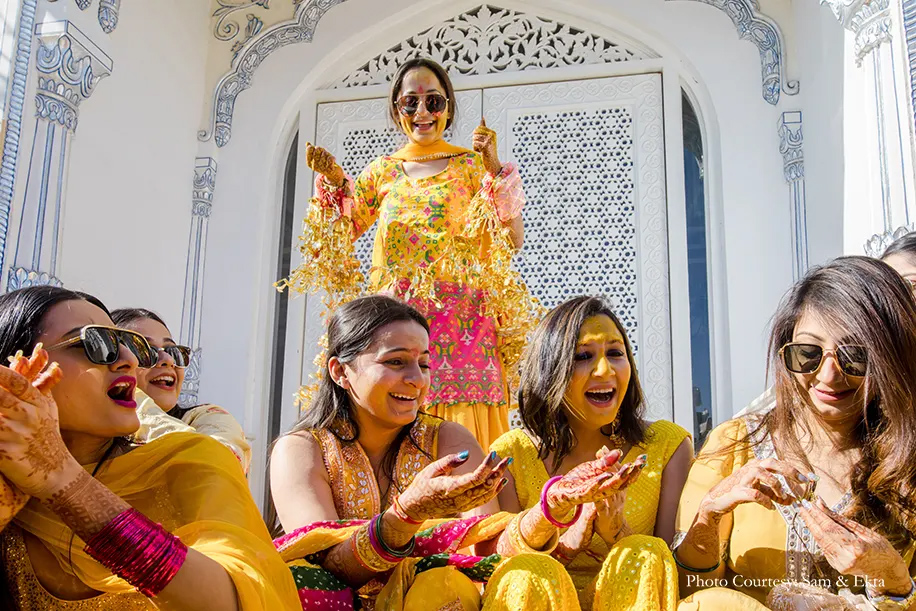 Photo Courtesy: Sam & Ekta
Photo Courtesy: Sam & Ekta
Haldi:
Once again, an integral part of Indian weddings, the Haldi entails joyful festivities wherein the bride and groom are smeared with a paste of turmeric, sandalwood, rose water and more, which gives them a golden glow for their wedding day! Traditionally held separately, today it is often a combined ceremony for the couple, and involves other fun activities.
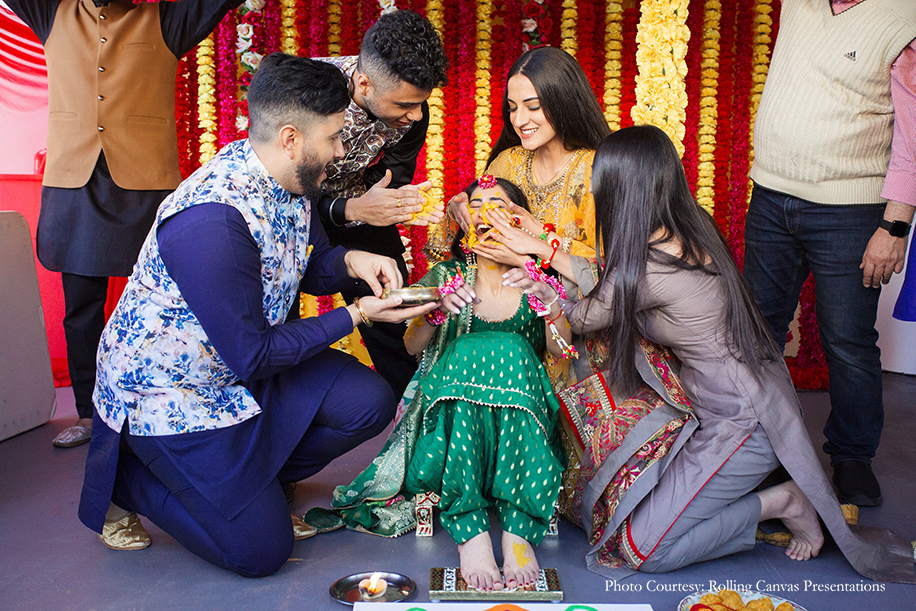 Photo Courtesy: Rolling Canvas Presentations
Photo Courtesy: Rolling Canvas Presentations
Ghara Gharoli:
Post the Haldi ceremony, the dried paste is scrubbed off and the bride and groom visit a nearby temple with their respective families. There, they are bathed with pitchers of holy water in the ceremony known as Ghara Gharoli. They then return to prepare for the wedding.
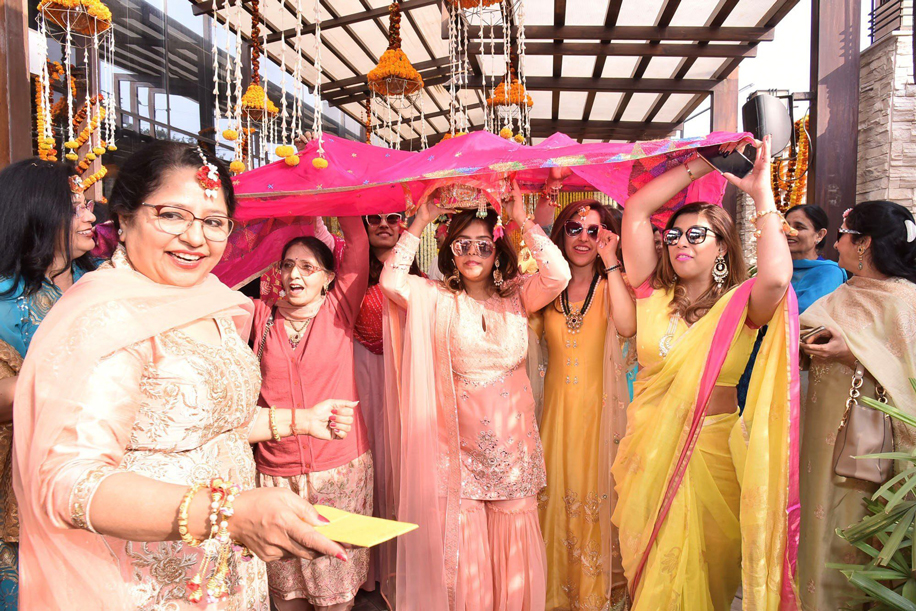 Photo Courtesy: My Pooja Box
Photo Courtesy: My Pooja Box
Sehra Bandi:
Once the groom dresses up in his wedding attire, a small puja is performed in his honor. The turban and the Sehra, which covers his face, is blessed by the priest and tied around his head by an elder male member of the family or his brother-in-law.
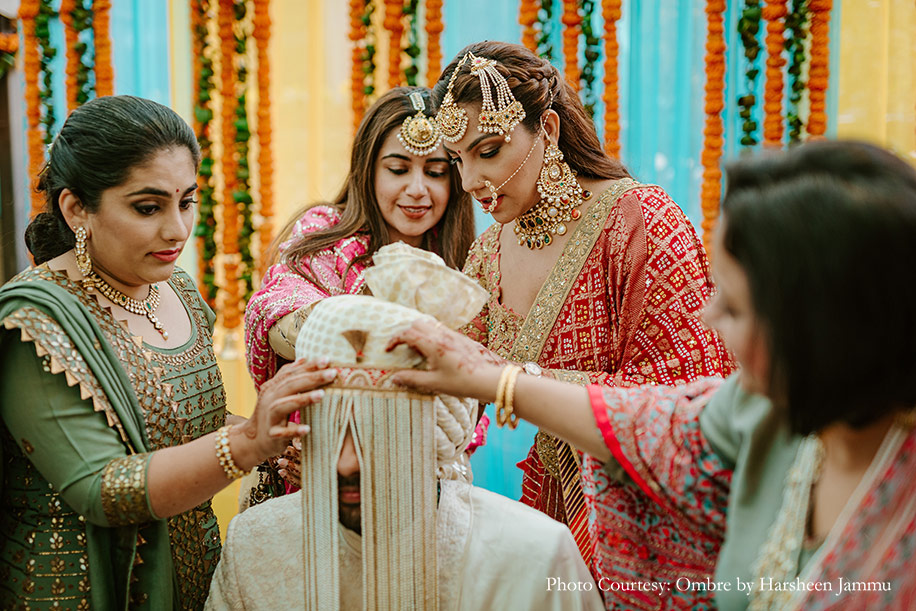 Photo Courtesy: Ombre by Harsheen Jammu
Photo Courtesy: Ombre by Harsheen Jammu
Ghodi Chadna:
The groom’s arrival on horseback in elaborate style is one of the most popular favorites and anticipated traditions of an Indian wedding. Traditionally, the Punjabi groom rides a decked up mare, which is smeared with a tikka and fed chana dal (lentils) and water by the female relatives of the groom. The groom then mounts the mare grandly, which is called (ghodi chadna), and sets off to the venue, with his dancing entourage or ‘baraat’.
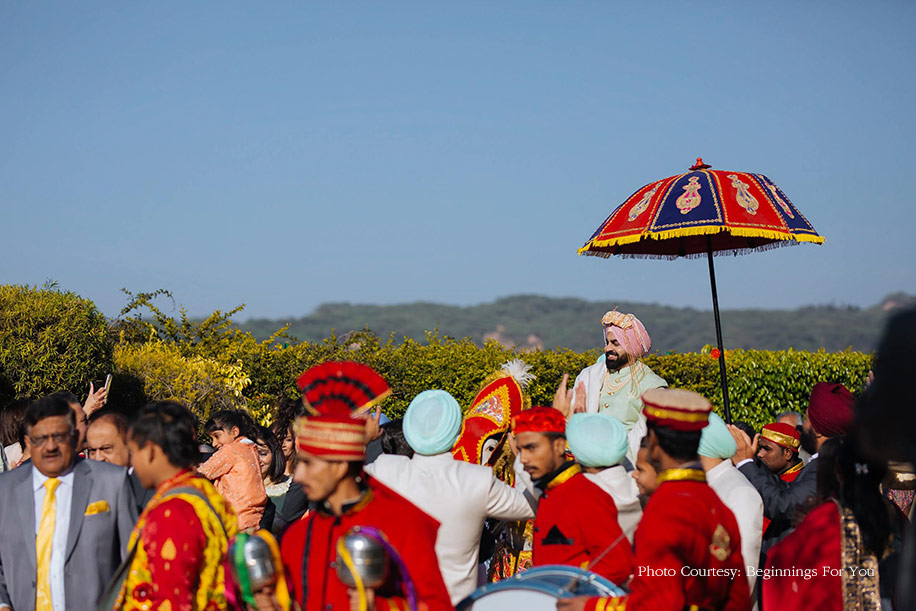 Photo Courtesy: Beginnings For You
Photo Courtesy: Beginnings For You
Milni:
The groom and the baraat are received at the wedding venue with a warm welcome by the bride’s family, with the mother receiving the groom with a traditional aarti and tikka. Then the groom’s relatives are embraced and welcomed by the bride’s corresponding relatives. For example, his maternal uncle is met by the bride’s maternal uncle and greeted, and so on and so forth, for Milni.
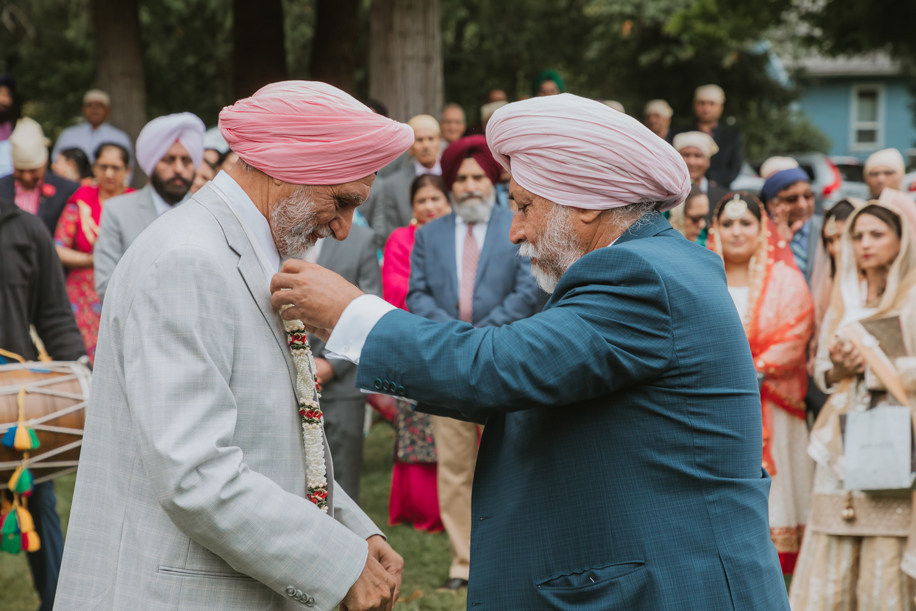 Photo Courtesy: Dreamfinity Studios
Photo Courtesy: Dreamfinity Studios
Varmala:
A joyous ceremony enjoyed by the couple, their family and the guests alike, the Varmala is the traditional garland exchange that the couple performs upon seeing each other. The groom is led to the stage on arrival, after which the bride enters with her family and climbs the stage for the ritual. The exchange is often made more fun by the couple’s friends picking them up, making it harder to do.
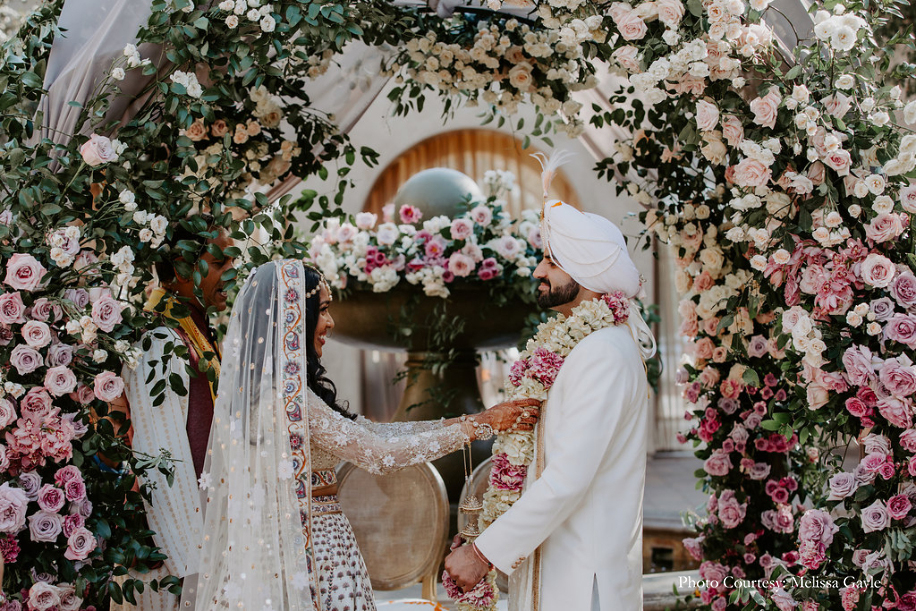 Photo Courtesy: Melissa Gayle
Photo Courtesy: Melissa Gayle
Madhuperk:
After the varmala, the couple proceed to the mandap, where the groom is offered a bowl of water to drink, after which he is given a special drink of curd, honey, milk, ghee and other sacred essences. This ritual is called madhuperk.
Kanyadaan:
A ritual that is present in some form or another in every culture and religion around the world, the Kanyadaan marks the ritual of the father giving away his daughter’s hand in marriage. With Vedic chants, he requests the groom to take care of his daughter, after which the groom accepts her hand and vows to love and protect her till death parts them.
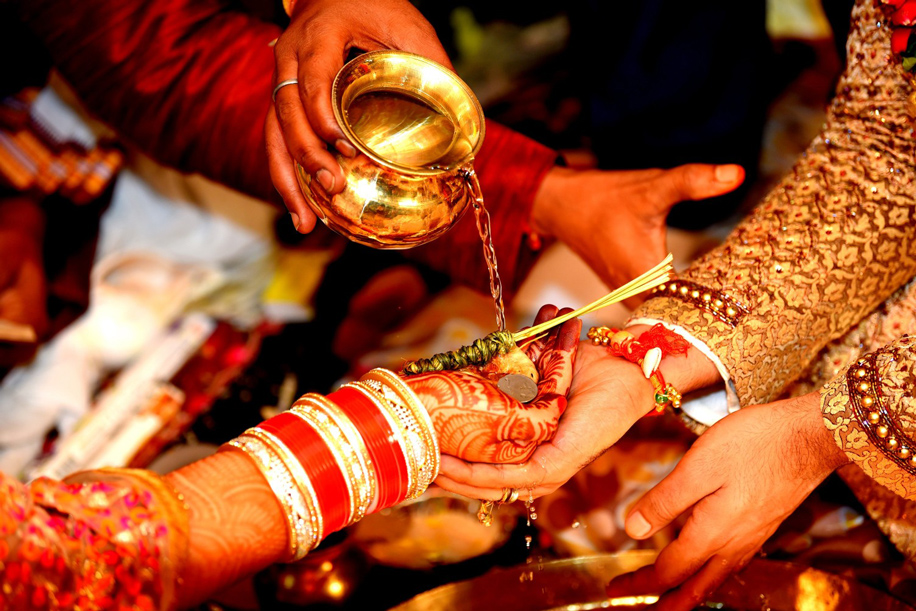 Photo Courtesy: Venue Look
Photo Courtesy: Venue Look
Mangal Phere:
The couple gets up for the phere. The ends of their drapes are tied together to signify their marital bond, after which they encircle the sacred fire four times as chants are read out, to symbolize their vows. The bride precedes the groom for three of them, and follows him for the last. The couple is considered to be married in the eyes of the fire goddess.
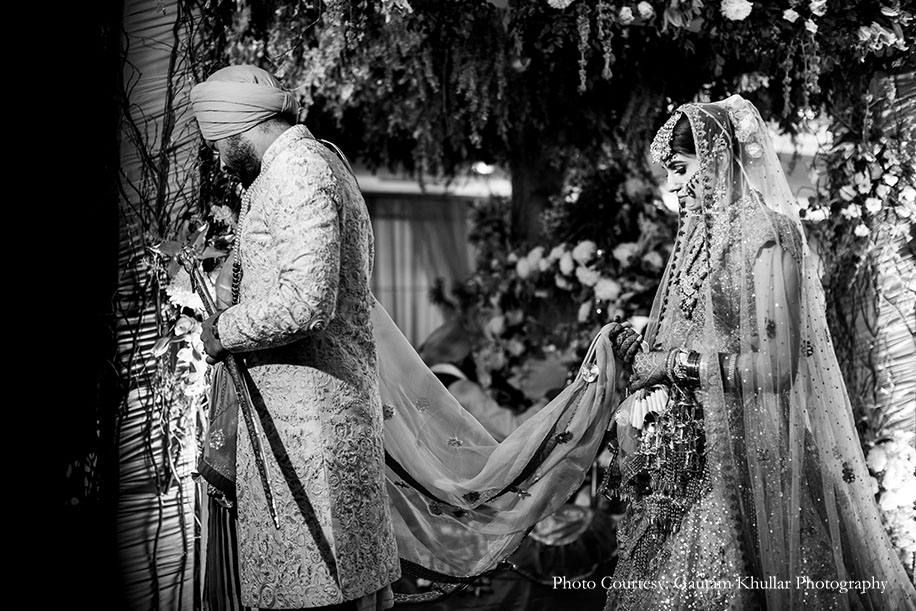 Photo Courtesy: Gautam Khullar Photography
Photo Courtesy: Gautam Khullar Photography
Lajahom:
For this ritual, the bride’s brother pours puffed rice into her cupped hands, which she and the groom offer to the fire and seek blessings. The process is repeated thrice.
 Photo Courtesy: Lin & Jirsa
Photo Courtesy: Lin & Jirsa
Sindoor Daan:
The groom finally applies sindoor (vermilion) on the bride’s hair parting and ties the mangalsutra around her neck, which binds them for life and concludes their wedding rituals
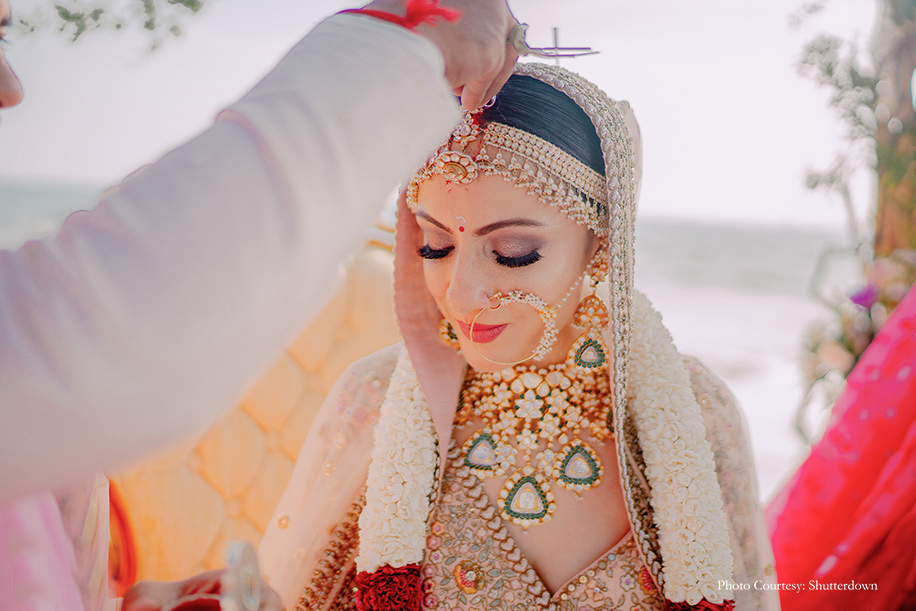 Photo Courtesy: Shutterdown
Photo Courtesy: Shutterdown
Joota Chupai:
Another cherished wedding tradition, Joota Chupai is a fun trick that the bride’s sisters play on the groom by stealing his shoes in the midst of the wedding. After the wedding, they demand a ransom in return of his shoes. After a lot of banter and frivolous bargaining, the groom gets his shoes back only when he gifts his sisters-in-law what they want.
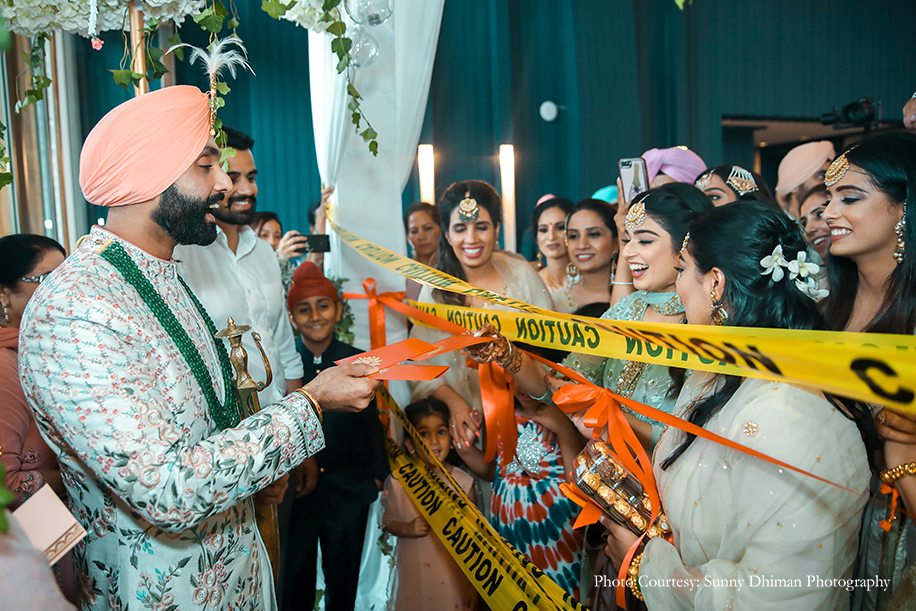 Photo Courtesy: Sunny Dhiman photography
Photo Courtesy: Sunny Dhiman photography
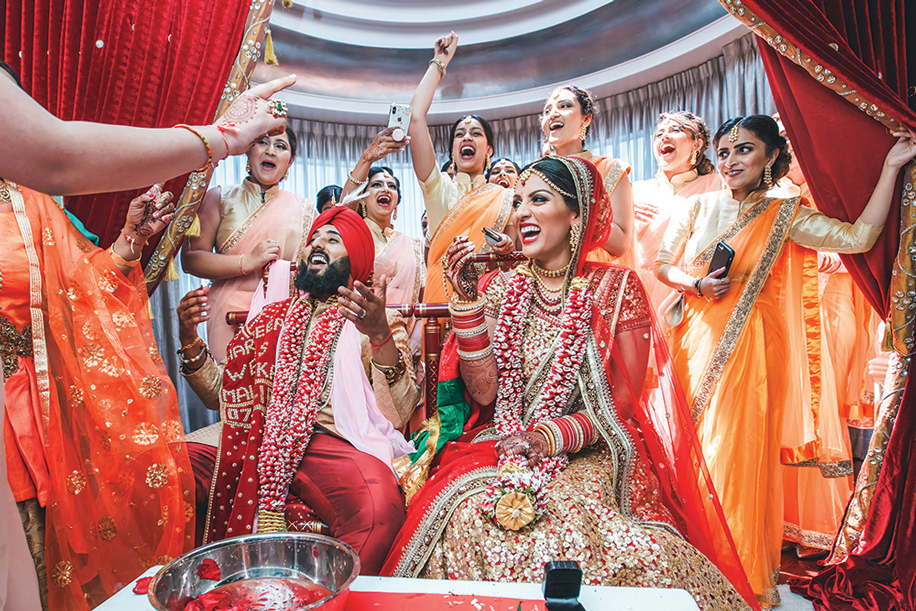 Photo Courtesy: Manhattan Bride
Photo Courtesy: Manhattan Bride
Vidaai and Doli:
The final goodbye in the Vidaai is a bitter-sweet ceremony, as the bride prepares to leave her home and family. After the teary embraces, the bride throws a handful of rice towards her home over her shoulder, symbolic of a thank you for taking care of her. She then climbs into a decorated car with her husband and leaves for her new home in a bridal procession called Doli.
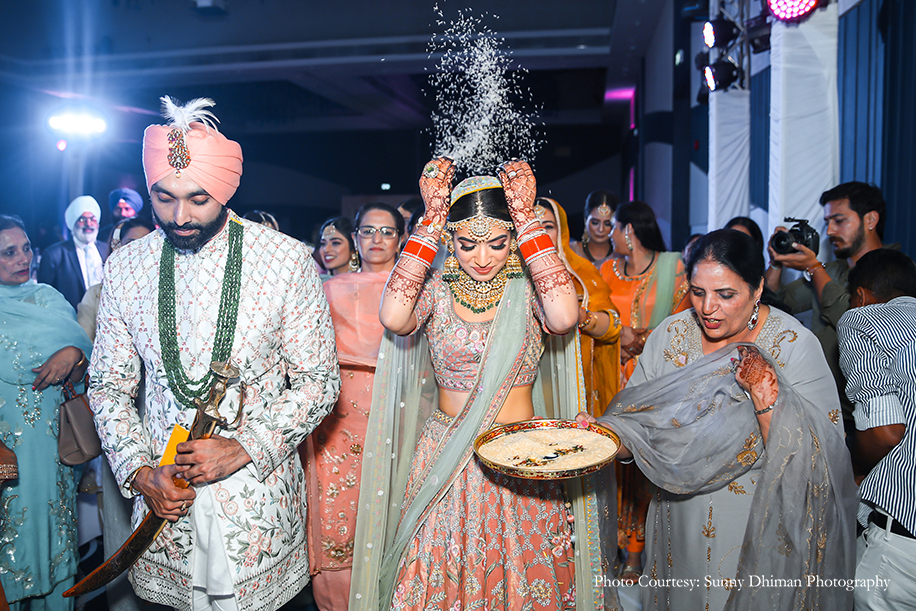 Photo Courtesy: Sunny Dhiman photography
Photo Courtesy: Sunny Dhiman photography
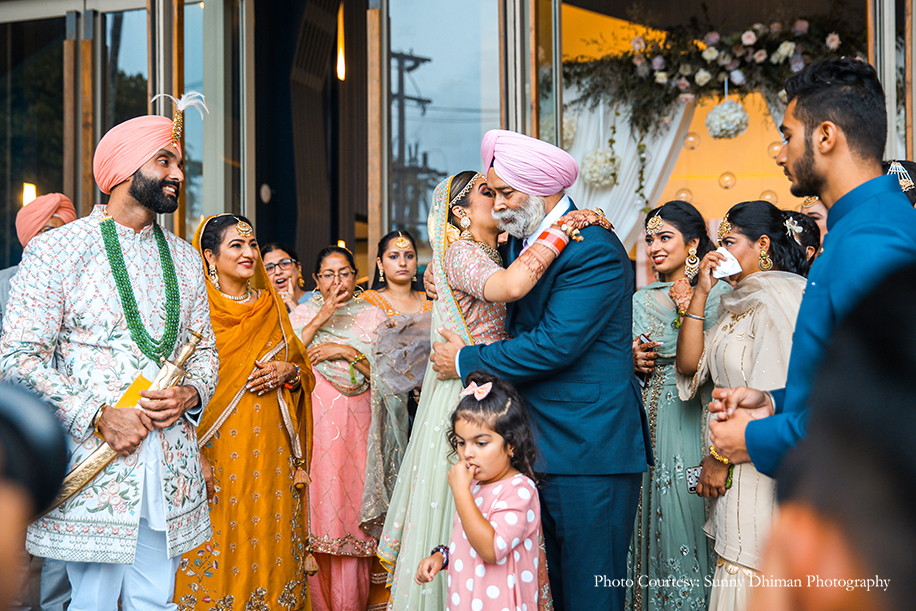 Photo Courtesy: Sunny Dhiman photography
Photo Courtesy: Sunny Dhiman photography
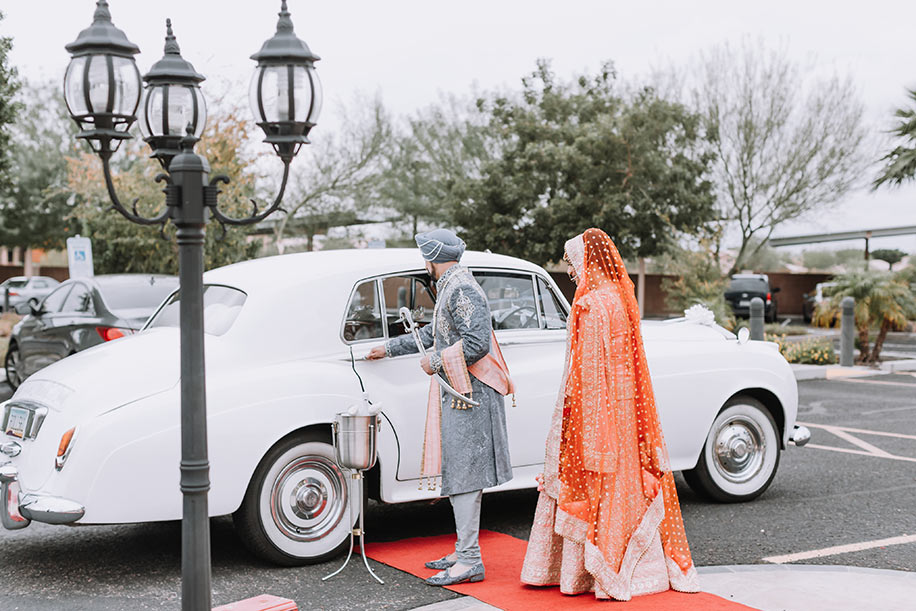 Photo Courtesy: Ushna Khan Photography
Photo Courtesy: Ushna Khan Photography
Things you are sure to see in a Punjabi Wedding
While all North-Indian Hindu weddings share common cultural and ritual nuances, there are some quintessentially Punjabi moments that you absolutely cannot miss at a wedding.
Group of Ladies singing folk songs:
An inherent part of weddings in Punjab, many ceremonies, such as Sangeet and Jaggo are accompanied by folk tunes and music, performed by female relatives, neighbors and friends.
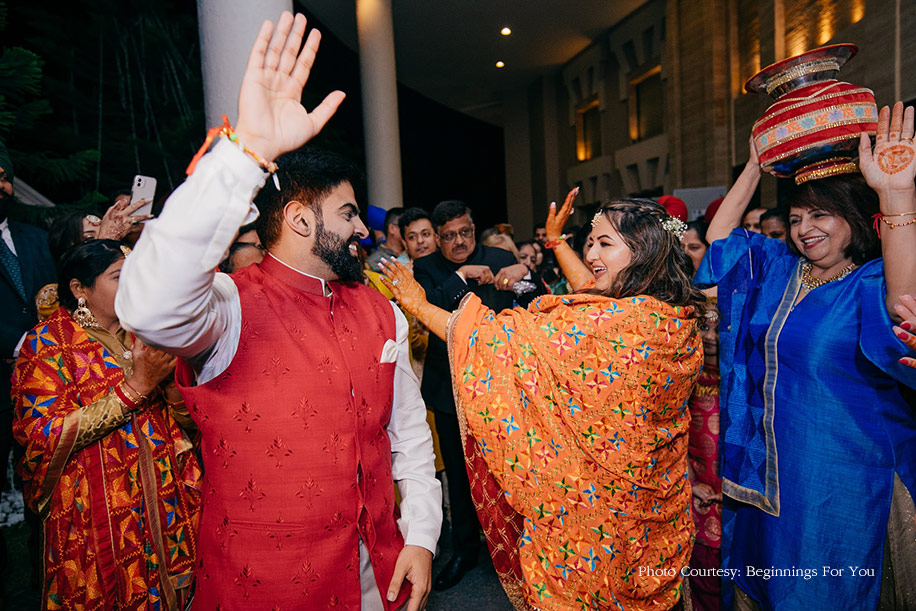 Photo Courtesy: Beginnings For You
Photo Courtesy: Beginnings For You
Loud, late Baraat:
With the never-ending stamina and love for dancing that the Punjabis are famously known for, it’s no surprise that most baraats never reach their destination at the scheduled time. The momentous energy and joy they bring with them however, is worth the wait!
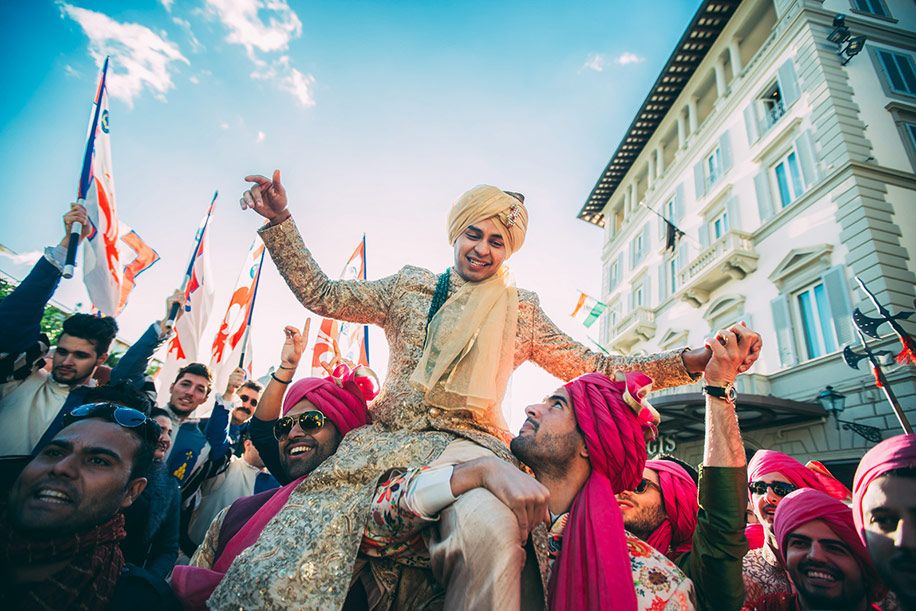
Money money everywhere!:
From flicking notes into the air to the ceremonial ‘note ferna’ and sometimes even the garland of notes placed on the groom during the baraat, the custom is symbolic of happiness and good luck for the future.
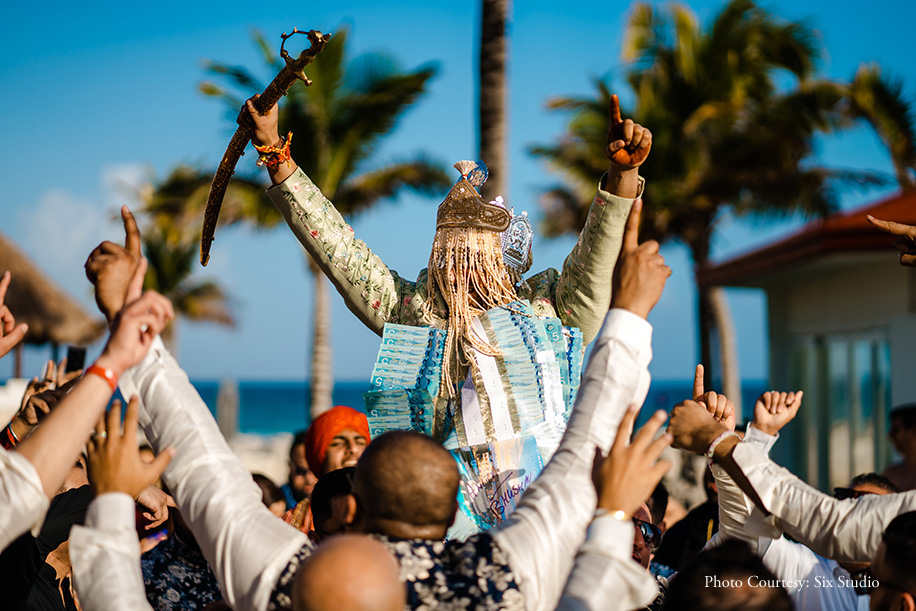 Photo Courtesy: Six Studio
Photo Courtesy: Six Studio
Dhols:
No Punjabi wedding is complete without the rousing sound of dhol beats! Be it the mehndi, sangeet or the wedding, every function begins and ends with the infectious energy and rhythmic beats of dholwallas.
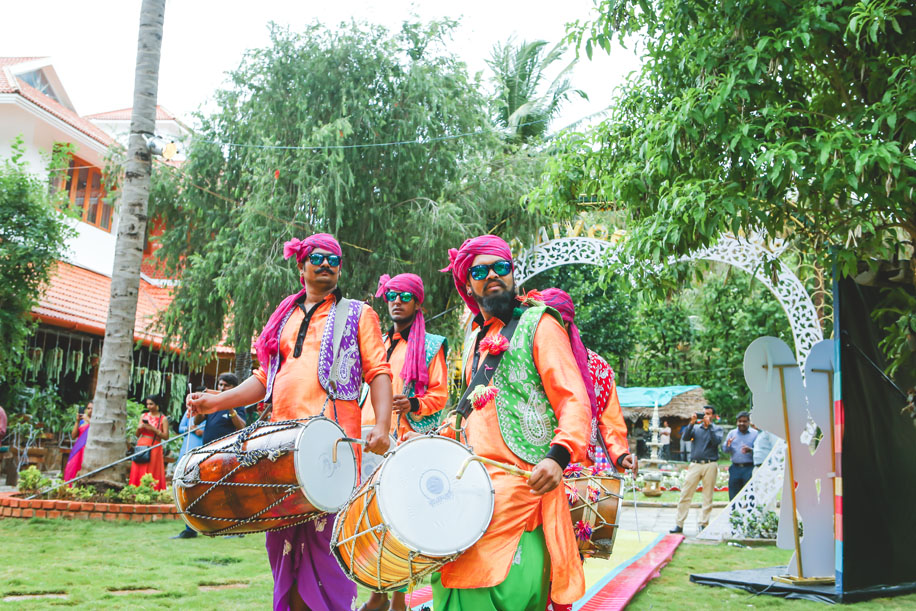 Photo Courtesy: Rainmaker Events and Entertainment
Photo Courtesy: Rainmaker Events and Entertainment
Lip-smacking food:
The Punjabis have always been famed for their love of food. Any and every celebration is a culinary extravaganza, with an enviable spread of rich and delicious food.
Bling, bling and more bling:
OTT and colorful as a culture, weddings are the perfect occasion to unleash the fashionista inside every Punjabi. And they absolutely love BLING and sparkly baubles which are displayed in style at every event!
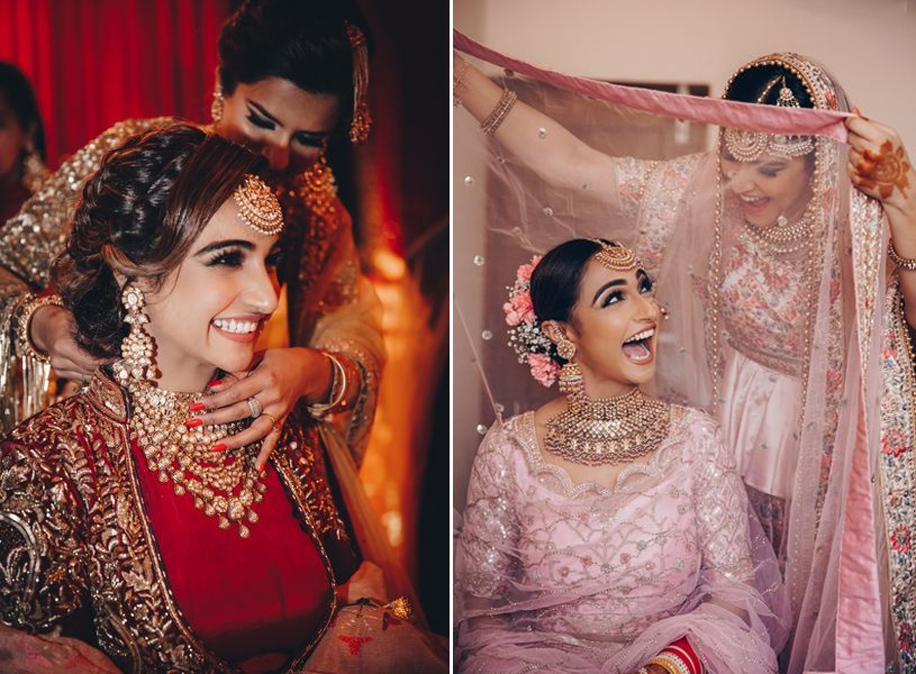 Photo Courtesy: Shades
Photo Courtesy: Shades
Open bar:
What Punjabi wedding is complete without some ‘daru sharu’? From uncles to aunties and even grannies, everyone loves their liquor, and an open bar is a definitive fixture in all celebrations.
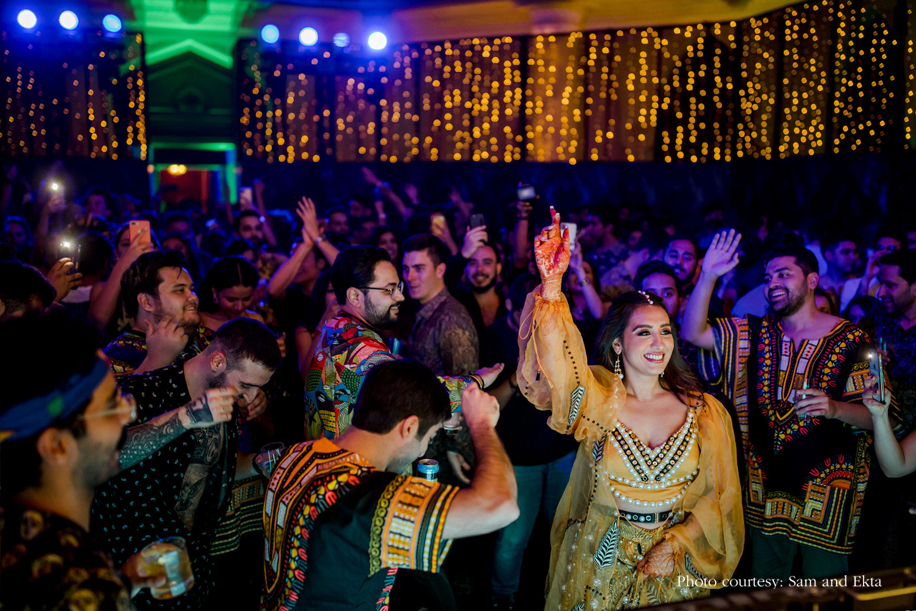 Photo Courtesy: Sam & Ekta
Photo Courtesy: Sam & Ekta
Fashion tips to immerse in the culture
Burst of colors:
Feel free to embrace the full spectrum of colors when it comes to building your wardrobe for a Punjabi wedding. It is undeniably going to be the most vibrant celebration of your life.
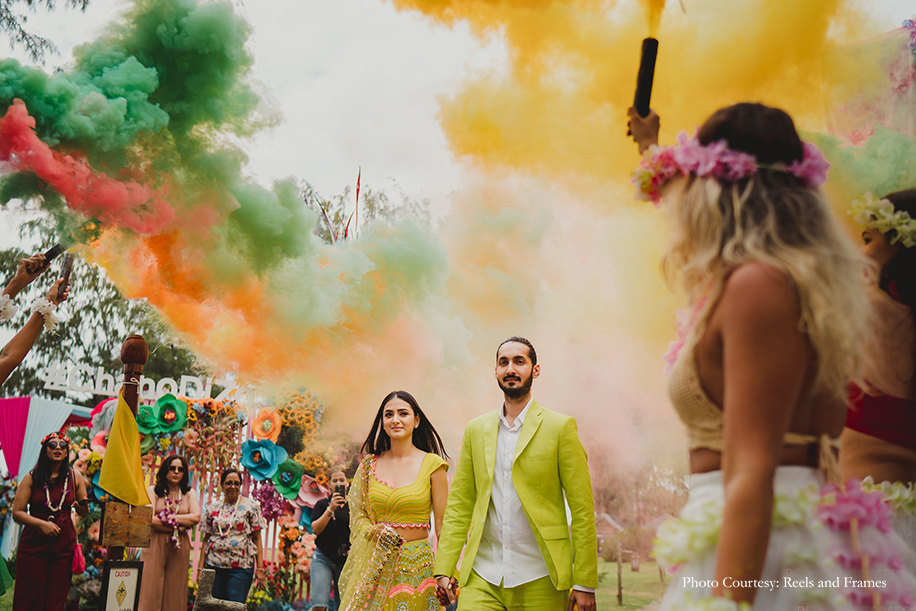 Photo Courtesy: Reels and Frames
Photo Courtesy: Reels and Frames
Bling, bling and more bling:
If you are a guest and you love sparkle, a Punjabi wedding is definitely the occasion to go all out on bling without the risk of overtaking the bride’s splendor, because rest assured, all her friends and relatives would be just as decked out! If you are a bridesmaid however, do check with the bride before splurging on your outfit so as to complement her look.
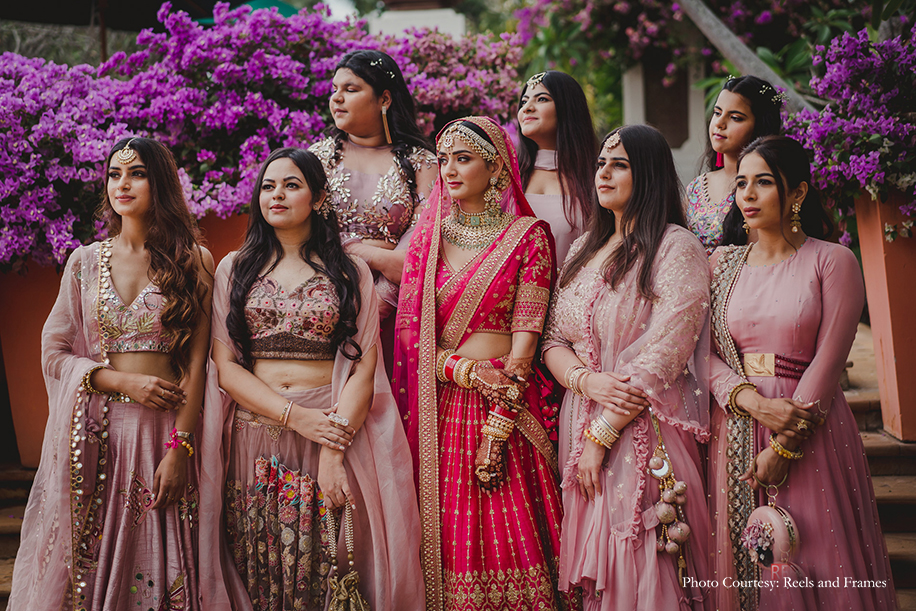 Photo Courtesy: Reels and Frames
Photo Courtesy: Reels and Frames
Phulkari:
An age old creative handicraft of Punjab, Phulkari holds a special place in Punjabi celebrations and was traditionally seen in dupattas and suits. The craft has today been woven into modern fashion with several designers putting their own spin on it across various contemporary silhouettes. Explore pastel shades in sarees for a timeless look or opt for a bright skirt or top for a mehndi function.
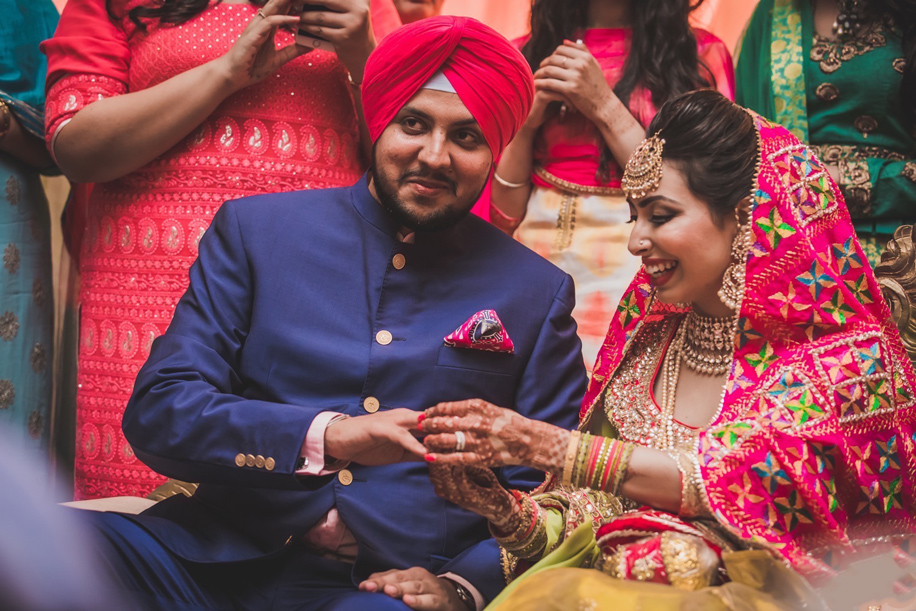 Photo Courtesy: Art Capture Productions
Photo Courtesy: Art Capture Productions
Exquisite Safas/Turbans:
Who says accessories are just for women? Safas and turbans are commonly worn by the friends and family and even guests for weddings, and can be a great way to add some style to your look. Keep an eye out for fun prints and colors with your attire.
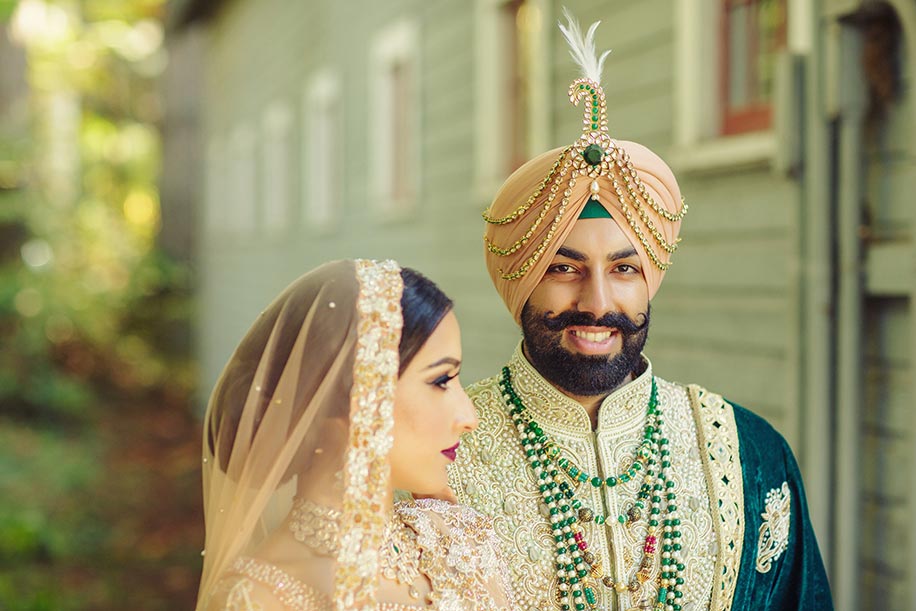 Photo Courtesy: Deo Studios
Photo Courtesy: Deo Studios
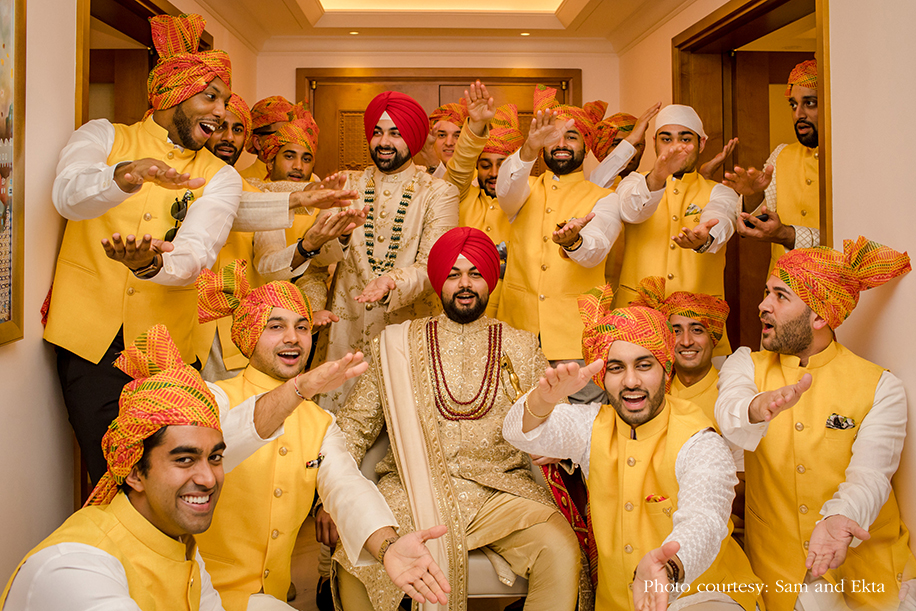 Photo Courtesy: Sam & Ekta
Photo Courtesy: Sam & Ekta
Elaborate sherwanis:
Elaborate fashion is just as popular for men in Punjabi culture as it is for women. So don’t stay confined to clichéd suits and kurtas when attending a wedding. Dress up in style with exquisite sherwanis, contemporary silhouettes and other fashion forward outfits.
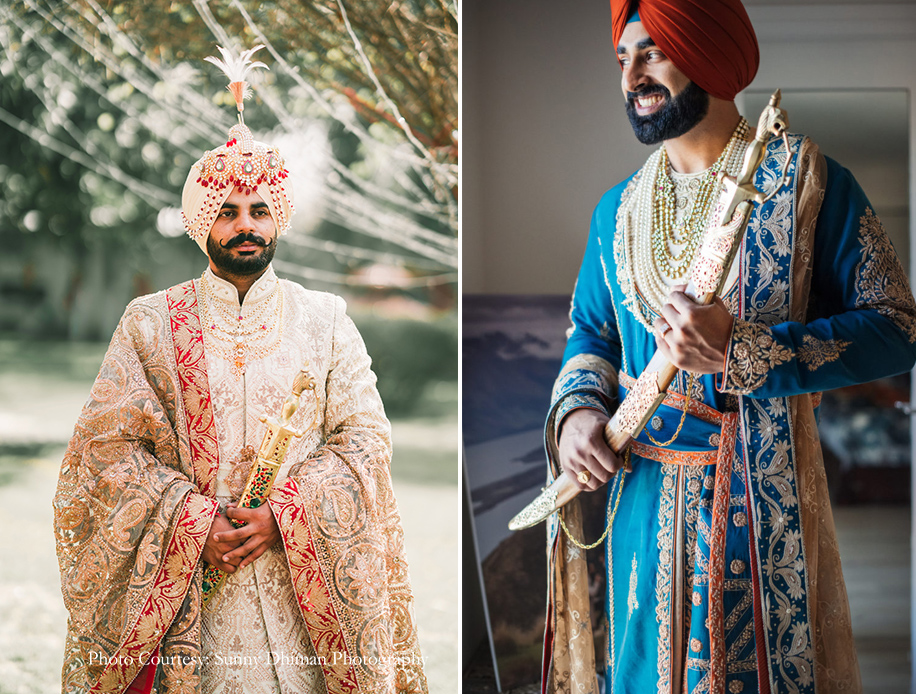
To start planning your wedding, click here


